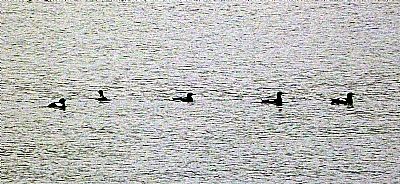GUILLEMOT, BLACK : Cepphus grylle
There is only one guillemot in Scotland, the black guillemot so we need not be too pendantic about its full name.
It is usually found further north of here so if you do see one or more in the small area of West Dunbartonshire's coastal waters, you will be extremely lucky.
Wiki tells us : The black guillemot or tystie (Cepphus grylle) is a medium-sized seabird of the Alcidae family, native throughout northern Atlantic coasts and eastern North American coasts. It is resident in much of its range, but large populations from the high arctic migrate southwards in winter. The bird can be seen in and around its breeding habitat of rocky shores, cliffs and islands in single or smalls groups of pairs. They feed mainly by diving towards the sea floor feeding on fish, crustaceans or other benthic invertebrates. [Wiki].
The RSPB adds : The Black Guillemot's striking black and white plumage and bright red feet make it easy to identify in summer. Unlike most other European auks the Black Guillemot is typically found solo or in pairs, scattered around small, rocky islands. It's typical of the larger sea lochs of western Scotland and the northern and western isles, but is also found in Ireland, the Isle of Man and in a handful of spots in England and Wales. [RSPB].
It was with some satisfaction therefore that the group of 5 were seen in June - unfortunately not within West Dunbartonshire waters, but off Rothesay in Bute. Their similarities to Goldeneye or Tufted ducks is evident at a distance such as this, but were confirmed by zooming in.

A group of 5 off Bute in June.
RSPB : https://www.rspb.org.uk/birds-and-wildlife/black-guillemot
WIKIPEDIA : https://en.wikipedia.org/wiki/Black_guillemot

